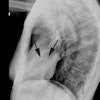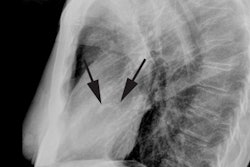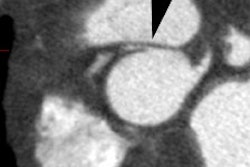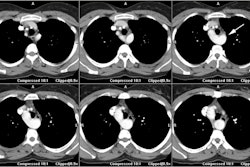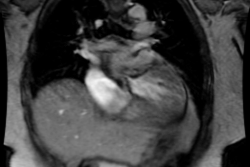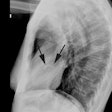Complications of cardiothoracic surgery:
Normal post-operative findings can persist for 2 to 3 weeks and include mild soft tissue infiltration with edema and blood in the presternal and retrosternal regions [5]. Focal air collections can be seen and generally resolve by 7 days post-op, although small foci of air can persist longer (up to 2 weeks [8]) [5]. Localized, well marginated fluid collections (or hematomas) can be seen [5]. The normal post-operative changes do not completely obliterate mediastinal fat planes and preserve some (or most) of the mediastinal fat lucency [5]. Most patients have defects in the sternum including gaps up to 4 mm wide, step-offs (sternal tables at different levels), and impaction (overriding of the sternal halves) [5]. Even 6 months after surgery, only 50% of patients show complete healing of the sternum (however, union should be complete by 1 year after the procedure) [5,8].
Acute Complications:
Atelectasis: Left lower lobe (90%) and right lower lobe atelectasis (60%) are very common following cardiothoracic surgery. Factors which contribute to left lower lobe atelectasis include splinting due to pain, the weight of the heart resting on the left lower lung in a recumbent patient, and transient or permanent phrenic nerve dysfunction.
Mediastinal bleeding: Significant post-operative bleeding requiring re-exploration following sternotomy occurs in up to 5% of patients. Predisposing factors include coagulopathy, anticoagulation, repeat sternotomy, and internal mammary artery grafting.
Cardiac tamponade:Tamponade occurs in 2-3% of patients immediately following surgery due to bleeding usually along the graft suture line.
Fractures: Acute fractures of the 1st and 2nd ribs can be seen in
2-4% of patients. A lucent stripe up to 3 mm can be seen in the
sternal split and is not necessarily a precursor of dehiscence.
Stroke: Stroke occurs in about 2.2% of patients [6]. During
surgery, the ascending aorta is clamped to initiate
cardiopulmonary bypass [6]. Patients with athersclerosis of the
ascending aorta have an almost five-fold higher risk of developing
a postoperative stroke [6]. Non-contrast CT can permit
visualization of aortic calcification as a marker of
atherosclerosis [6].
Delayed complications:
Sternal nonunion:
Clinical:
The incidence of sternal nonunion is between 0.5-3% [8]. Risk
factors include obesity, osteoporosis, chest wall radiation,
steroid use, paramedian closure, and internal mammary harvest [8].
It can be classified as partial or complete.
Sternal dehiscence:
Clinical:
Sternal dehiscence is an uncommon, but serious complication of
median sternotomy (1-2% of cases [4]). Predisposing factors
include age over 60 years, osteopenia, COPD, obesity, diabetes,
prolonged bypass time during surgery, internal mammary artery
grafting, repeat surgery for mediastinal bleeding, and prolonged
post-operative ventilation [4,8]. A paramedian sternotomy (defined
as an off-center sternotomy incision) also predisposes to
dehiscence because the thin side of the sternum can be broken by
the closing wires [5]. Most cases occur about 9 days following
surgery (range 1-40 days) [8]. Dehiscence is associated with
mediastinitis in about 50% of cases [2]. Radiographic findings can
precede the clinical diagnosis by up to 3 days [8].
X-ray:
The "midsternal stripe sign" - a midline vertical lucency over the sternum of greater than 3 mm is usually abnormal and should raise the suspicion for dehiscence [4]. A progressively widening midsternal stripe is another indication of sternal dehiscence [4]. "Wandering sternal wires" (one or more newly misaligned wires [4]) is a highly specific finding for dehiscence. Displacement of sternal wires can be seen on CXR in about 85% of cases of dehiscence. Rotation (50%) or disruption (20%) can also be seen. Wire abnormalities precede clinical detection of dehiscence by a mean of 3 days in 70% of cases, but this finding is generally not noted prospectively.
Sternal wound infection/Osteomyelitis:
Wound infection occurs in about 1% of patients. The major risk
factors include prolonged ventilation, combined coronary and valve
surgery, re-exploration for bleeding, and infection elsewhere.
Patients complain of pain, erythema and wound drainage, fever, and
leukocytosis. Blood cultures are positive in about 58% of cases.
The infection can be complicated by osteomyelitis. Staph species
are the most common organism [8]. Imaging will demonstrate
cortical erosion and bone destruction [8].
Mediastinitis- see discussion under Infection section
Post Pericardiotomy Syndrome:
The syndrome is possibly autoimmune and can occur from days to months following the surgery. Patients present with pericarditis, pleuritis, or both, with fever, elevated sedimentation rate, and elevated WBC count. Patients who have had a mediastinal or pericardial hematoma are more likely to develop this syndrome. Generally the syndrome is self-limited and treated with anti-inflammatory agents. It may be complicated by constrictive pericarditis.
Constrictive pericarditis:
Constrictive pericarditis occurs in about 0.2% of sternotomy patients from months to years following the surgery. About half of the affected patients will have a history of pericardial bleeding, mediastinal bleeding, or post-pericardiotomy syndrome.
Vascular complications
Pseudoaneurysm and ascending aortic dissection:
Ascending aortic complciations occur in about 1% of patients usually at the site of cardiopulmonary bypass, site of aortotomy for aortic valve replacement, or at the site of bypass graft anastomosis.
Coronary artery vein graft aneurysm:
True aneurysmal dilatation of a saphenous vein graft is very rare
[3]. Most aneurysms are false aneurysms occurring at anastomotic
sites, ligated branch sites (a natural area of weakness), and in
the area of valves (also an area of natural weakness) [3]. Vein
grafts are particularly susceptible to false aneurysm formation
when one cosiders that they lack circular muscle in the media [3].
Treatment in generally surgical [3].
Pulmonary embolism:
Incidental pulmonary embolism following CABG can be seen in up to
6% of patients [7]. In one study, these unsuspected small PEs were
managed conservatively without anticoagulation and resolved
spontaneously without cardiovascular complication [7].
REFERENCES:
(1) Society of Thoracic Radiology Annual Meeting 2000 Course Syllabus; Shepard JO. Complications of cardiothoracic surgery. 153-155
(2) Society of Thoracic Radiology Annual Meeting 2000 Course Syllabus; Boiselle PM, et al. Sternal dehiscence with and without associated mediastinitis: Frequency of sternal wire abnormalities and time interval from surgery to diagnosis. 131
(3) Acta Cardiol 2001; Dubois CL, Vandercoort PM. Aneurysms and pseudoaneurysms of coronary arteries and saphenous vein coronary artery bypass grafts: a case report and literature review. 56: 263-267
(4) AJR 2002; Boiselle PM, Mansilla AV. A closer look at the midsternal stripe sign. 178: 945-48
(5) AJR 2003; Li AE, Fishman EK. Evaluation of complications
after sternotomy using single- and multidetector CT with
three-dimensional volume rendering. 181: 1065-1070
(6) J Cardiovasc Comput Tomogr 2016; den Harder AM, et al. Ultra
low-dose chest CT with iterative reconstructions as an alternative
to conventional chest x-ray prior to heart surgery (CRICKET
study): rationale and design of a multicenter randomized trial.
10: 242-245
(7) AJR 2018; Beck KS, et al. Incidental pulmonary embolism after
coronary artery bypass surgery: long-term clinical follow-up. 210:
52-57
(8) AJR 2018; Hota P, et al. Poststernotomy complications: a
multimodality review of normal and abnormal post operative imaging
findings. 211: 1194-1205
